Label-Free Impedimetric Immunosensors Modulated by Protein A/Bovine Serum Albumin Layer for Ultrasensitive Detection of Salbutamol
Abstract
1. Introduction
2. Materials and Methods
2.1. Reagents and Chemicals
2.2. AuNS Deposition
2.3. Immunosensor Preparation
2.4. Electrochemical Measurements
3. Results and Discussion
3.1. Morphology and Roughness of AuNS/SPCEs
3.2. Effect of PA and BSA Mixture
3.3. Calibration Curves
3.4. Other Sensing Properties
4. Conclusions
Author Contributions
Funding
Acknowledgments
Conflicts of Interest
References
- Filik, H.; Avan, A.A. Nanostructures for nonlabeled and labeled electrochemical immunosensors: Simultaneous electrochemical detection of cancer markers: A review. Talanta 2019, 205, 120153. [Google Scholar] [CrossRef] [PubMed]
- Bahadır, E.B.; Sezgintürk, M.K. Applications of electrochemical immunosensors for early clinical diagnostics. Talanta 2015, 132, 162–174. [Google Scholar] [CrossRef] [PubMed]
- Hosu, O.; Selvolini, G.; Marrazza, G. Recent advances of immunosensors for detecting food allergens. Curr. Opin. Electrochem. 2018, 10, 149–156. [Google Scholar] [CrossRef]
- Picardo, M.; Filatova, D.; Nuñez, O.; Farré, M. Recent advances in the detection of natural toxins in freshwater environments. Trac-Trend Anal. Chem. 2019, 112, 75–86. [Google Scholar] [CrossRef]
- Zhou, J.; Qi, Q.; Wang, C.; Qian, Y.; Liu, G.; Wang, Y.; Fu, L. Surface plasmon resonance (SPR) biosensors for food allergen detection in food matrices. Biosens. Bioelectron. 2019, 142, 111449. [Google Scholar] [CrossRef]
- Kurosawa, S.; Park, J.-W.; Aizawa, H.; Wakida, S.-I.; Tao, H.; Ishihara, K. Quartz crystal microbalance immunosensors for environmental monitoring. Biosens. Bioelectron. 2006, 22, 473–481. [Google Scholar] [CrossRef]
- Suri, C.R.; Boro, R.; Nangia, Y.; Gandhi, S.; Sharma, P.; Wangoo, N.; Rajesh, K.; Shekhawat, G.S. Immunoanalytical techniques for analyzing pesticides in the environment. Trac-Trend Anal. Chem. 2009, 28, 29–39. [Google Scholar]
- Zhang, H.; Miller, B.L. Immunosensor-based label-free and multiplex detection of influenza viruses: State of the art. Biosens. Bioelectron. 2019, 141, 111476. [Google Scholar] [CrossRef]
- Prodromidis, M.I. Impedimetric immunosensors—A review. Electrochim. Acta 2010, 55, 4227–4233. [Google Scholar] [CrossRef]
- Li, M.; Li, Y.T.; Li, D.W.; Long, Y.T. Recent developments and applications of screen-printed electrodes in environmental assays—A review. Anal. Chim. Acta 2012, 734, 31–44. [Google Scholar] [CrossRef]
- Kokkinos, C.; Economou, A.; Prodromidis, M.I. Electrochemical immunosensors: Critical survey of different architectures and transduction strategies. Trac-Trend Anal. Chem. 2016, 79, 88–105. [Google Scholar] [CrossRef]
- Ricci, F.; Adornetto, G.; Palleschi, G. A review of experimental aspects of electrochemical immunosensors. Electrochim. Acta 2012, 84, 74–83. [Google Scholar] [CrossRef]
- Wu, C.C.; Ku, B.C.; Ko, C.H.; Chiu, C.C.; Wang, G.J.; Yang, Y.H.; Wu, S.J. Electrochemical impedance spectroscopy analysis of A-beta (1-42) peptide using a nanostructured biochip. Electrochim. Acta 2014, 134, 249–257. [Google Scholar] [CrossRef]
- Zhong, G.X.; Wang, P.; Fu, F.H.; Weng, S.H.; Chen, W.; Li, S.G.; Liu, A.L.; Wu, Z.Y.; Zhu, X.; Lin, X.H.; et al. Electrochemical immunosensor for detection of topoisomerase based on graphene–gold nanocomposites. Talanta 2014, 125, 439–445. [Google Scholar] [CrossRef] [PubMed]
- Ma, H.; Sun, J.; Zhang, Y.; Bian, C.; Xia, S.; Zhen, T. Label-free immunosensor based on one-step electrodeposition of chitosan-gold nanoparticles biocompatible film on Au microelectrode for determination of aflatoxin B1 in maize. Biosens. Bioelectron. 2016, 80, 222–229. [Google Scholar] [CrossRef]
- Welch, N.G.; Scoble, J.A.; Muir, B.W.; Pigram, P.J. Orientation and characterization of immobilized antibodies for improved immunoassays. Biointerphases 2017, 12, 02D301. [Google Scholar] [CrossRef]
- Wang, C.; Feng, B. Research progress on site-oriented and three-dimensional immobilization of protein. Mol. Biol. 2015, 49, 1–20. [Google Scholar] [CrossRef]
- Rusmini, F.; Zhong, Z.; Feijen, J. Protein Immobilization Strategies for Protein Biochips. Biomacromolecules 2007, 8, 1775–1789. [Google Scholar] [CrossRef]
- Billah, M.M.; Hodges, C.S.; Hays, H.C.W.; Millner, P.A. Directed immobilization of reduced antibody fragments onto a novel SAM on gold for myoglobin impedance immunosensing. Bioelectrochemistry 2010, 80, 49–54. [Google Scholar] [CrossRef]
- Ferreira, N.S.; Sales, M.G.F. Disposable immunosensor using a simple method for oriented antibody immobilization for label-free real-time detection of an oxidative stress biomarker implicated in cancer diseases. Biosens. Bioelectron. 2014, 53, 193–199. [Google Scholar] [CrossRef]
- Lu, B.; Smyth, M.R.; O’Kennedy, R. Tutorial review. Oriented immobilization of antibodies and its applications in immunoassays and immunosensors. Analyst 1996, 121, 29R–32R. [Google Scholar] [CrossRef] [PubMed]
- Iijima, M.; Kuroda, S. Scaffolds for oriented and close-packed immobilization of immunoglobulins. Biosens. Bioelectron. 2017, 15, 810–821. [Google Scholar]
- Wang, R.; Wang, Y.; Lassiter, K.; Li, Y.; Hargis, B.; Tung, S.; Berghman, L.; Bottje, W. Interdigitated array microelectrode based impedance immunosensor for detection of avian influenza virus H5N1. Talanta 2009, 79, 159–164. [Google Scholar] [CrossRef] [PubMed]
- Hafaiedh, I.; Chammem, H.; Abdelghani, A.; Ait, E.; Feldman, L.; Meilhac, O.; Mora, L. Supported protein G on gold electrode: Characterization and immunosensor application. Talanta 2013, 116, 84–90. [Google Scholar] [CrossRef]
- Boujday, S.; Bantegnie, A.; Briand, E.; Marnet, P.G.; Salmain, M.; Pradier, C.M. In-Depth Investigation of Protein Adsorption on Gold Surfaces: Correlating the Structure and Density to the Efficiency of the Sensing Layer. J. Phys. Chem. B 2008, 112, 6708–6715. [Google Scholar] [CrossRef]
- Lin, C.-H.; Wu, C.-C.; Kuo, Y.-F. A high sensitive impedimetric salbutamol immunosensor based on the gold nanostructure-deposited screen-printed carbon electrode. J. Electroanal. Chem. 2016, 768, 27–33. [Google Scholar] [CrossRef]
- Wu, C.C.; Lin, C.H.; Wang, W.S. Development of an enrofloxacin immunosensor based on label-free electrochemical impedance spectroscopy. Talanta 2009, 79, 62–67. [Google Scholar] [CrossRef]
- Sharma, V.; Mishra, S.K.; Biradar, A.M. Synthesis and electrochemical characterization of myoglobin-antibody protein immobilized self-assembled gold nanoparticles on ITO-glass plate. Mater. Chem. Phys. 2012, 132, 22–28. [Google Scholar]
- Cui, Z.; Cai, Y.; Wu, D.; Yu, H.; Li, Y.; Mao, K.; Wang, H.; Fan, H.; Wei, Q.; Du, B. An ultrasensitive electrochemical immunosensor for the detection of salbutamol based on Pd@SBA-15 and ionic liquid. Electrochim. Acta 2012, 69, 79–85. [Google Scholar] [CrossRef]
- Wang, H.; Zhang, Y.; Li, H.; Du, B.; Ma, H.; Wu, D.; Wei, Q. A silver–palladium alloy nanoparticle-based electrochemical biosensor for simultaneous detection of ractopamine, clenbuterol and salbutamol. Biosens. Bioelectron. 2013, 49, 14–19. [Google Scholar] [CrossRef]
- Chen, D.; Yang, M.; Zheng, N.; Xie, N.; Liu, D.; Xie, C.; Yao, D. A novel aptasensor for electrochemical detection of ractopamine, clenbuterol, salbutamol, phenylethanolamine and procaterol. Biosens. Bioelectron. 2016, 80, 525–531. [Google Scholar] [CrossRef]
- Chenga, J.; Su, X.-O.; Han, C.; Wang, S.; Wang, P.; Zhang, S.; Xie, J. Ultrasensitive detection of salbutamol in animal urine by immunomagnetic bead treatment coupling with surface-enhanced Raman spectroscopy. Sens. Actuators B 2018, 255, 2329–2338. [Google Scholar] [CrossRef]
- Li, M.; Zhang, Y.; Xue, Y.; Hong, X.; Cui, Y.; Liu, Z.; Du, D. Simultaneous determination of b2-agonists clenbuterol and salbutamol in water and swine feed samples by dual-labeled time-resolved fluoroimmunoassay. Food Control 2017, 73, 1039–1044. [Google Scholar] [CrossRef]
- Dawan, S.; Kanatharana, P.; Wongkittisuksa, B.; Limbut, W.; Numnuam, A.; Limsakul, C.; Thavarungkul, P. Label-free capacitive immunosensors for ultra-trace detection based on the increase of immobilized antibodies on silver nanoparticles. Anal. Chim. Acta 2011, 699, 232–241. [Google Scholar] [CrossRef] [PubMed]
- Thavarungkul, P.; Dawan, S.; Kanatharana, P.; Asawatreratanakul, P. Detecting penicillin G in milk with impedimetric label-free immunosensor. Biosens. Bioelectron. 2007, 23, 688–694. [Google Scholar] [CrossRef] [PubMed]
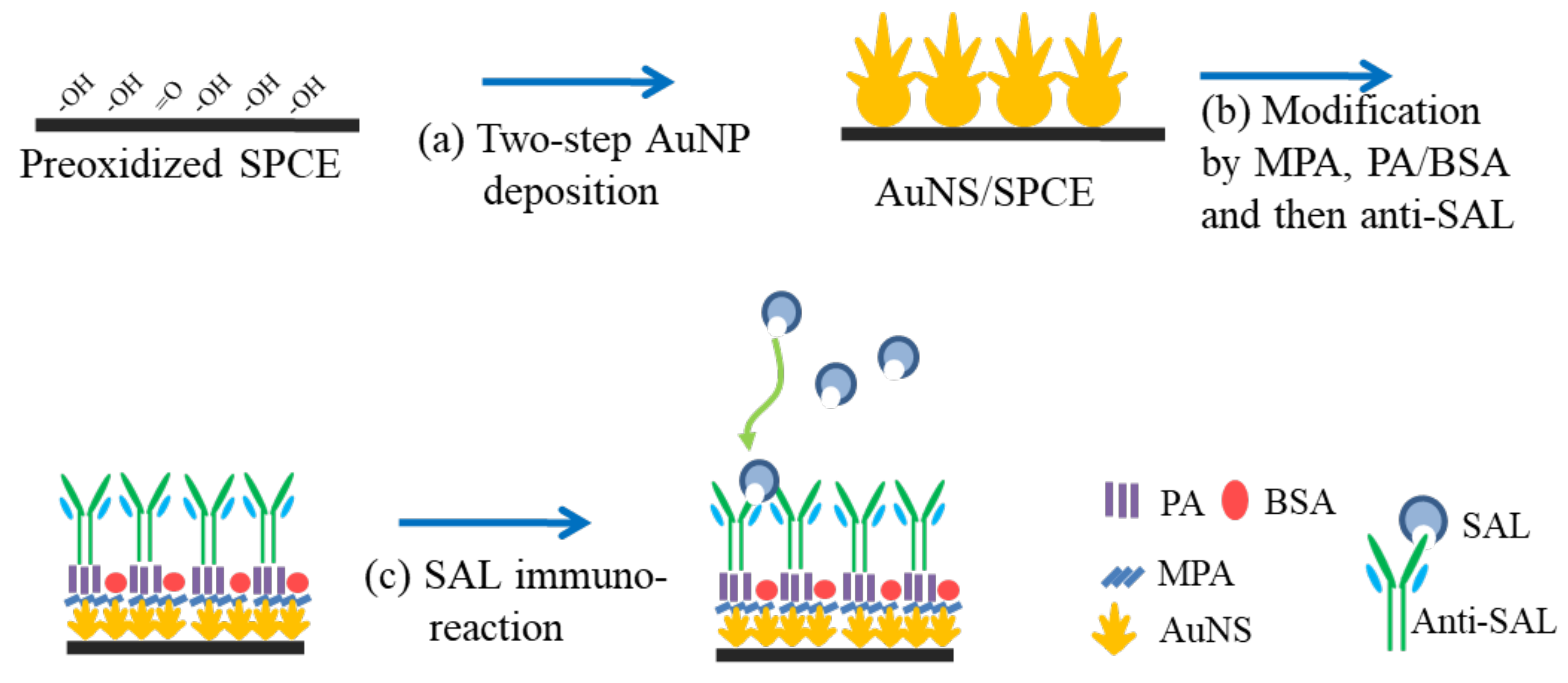
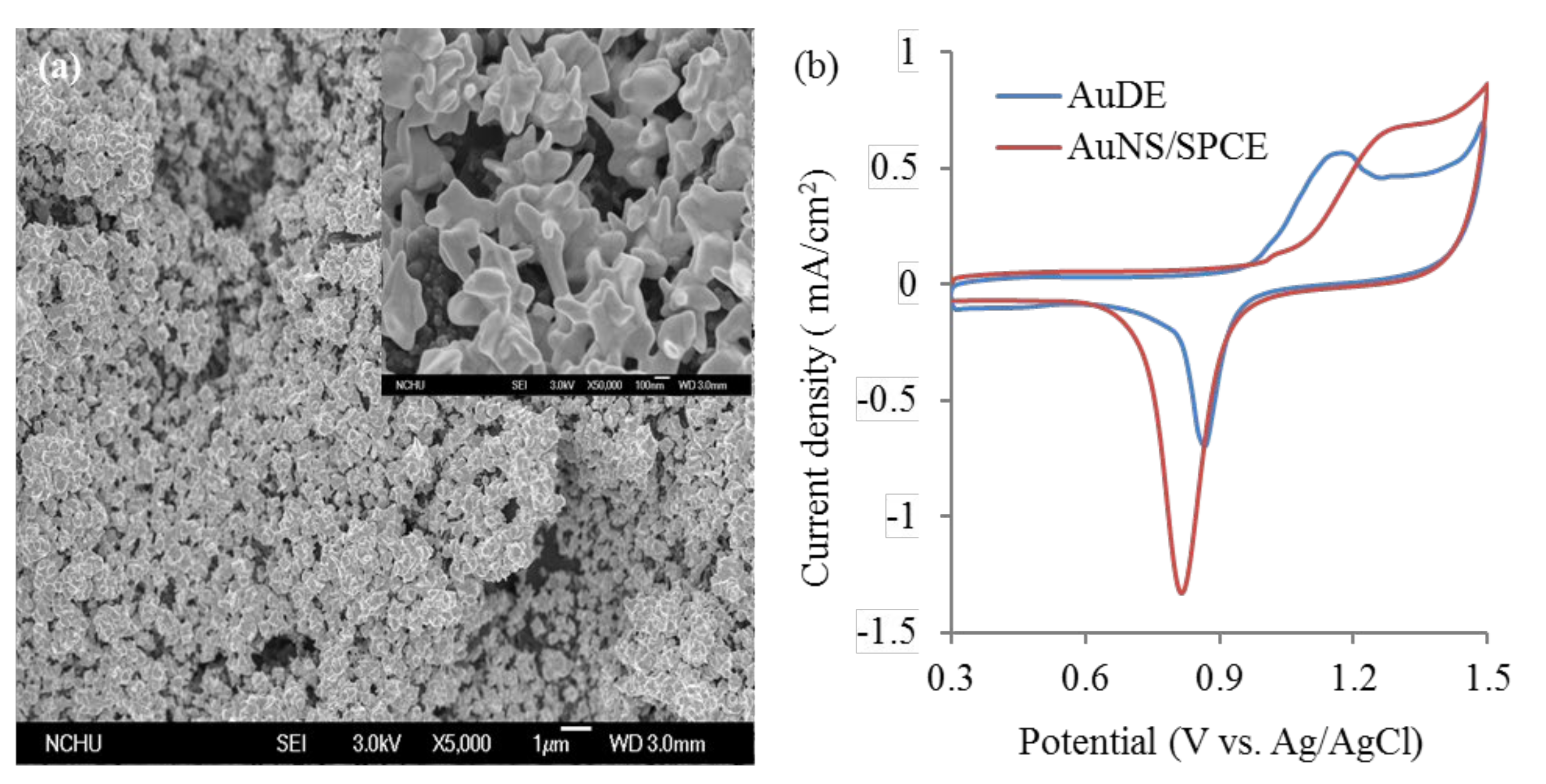
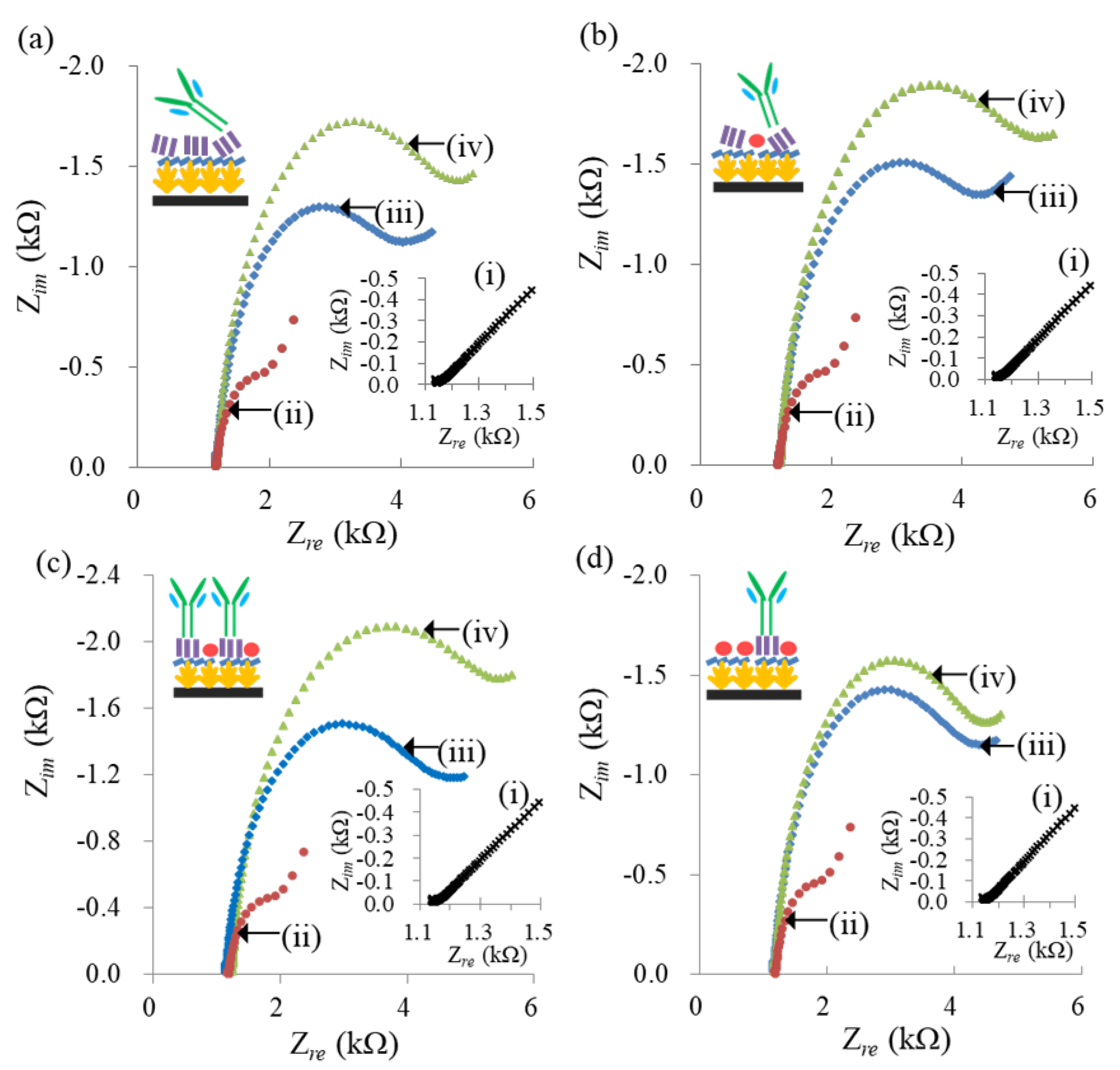
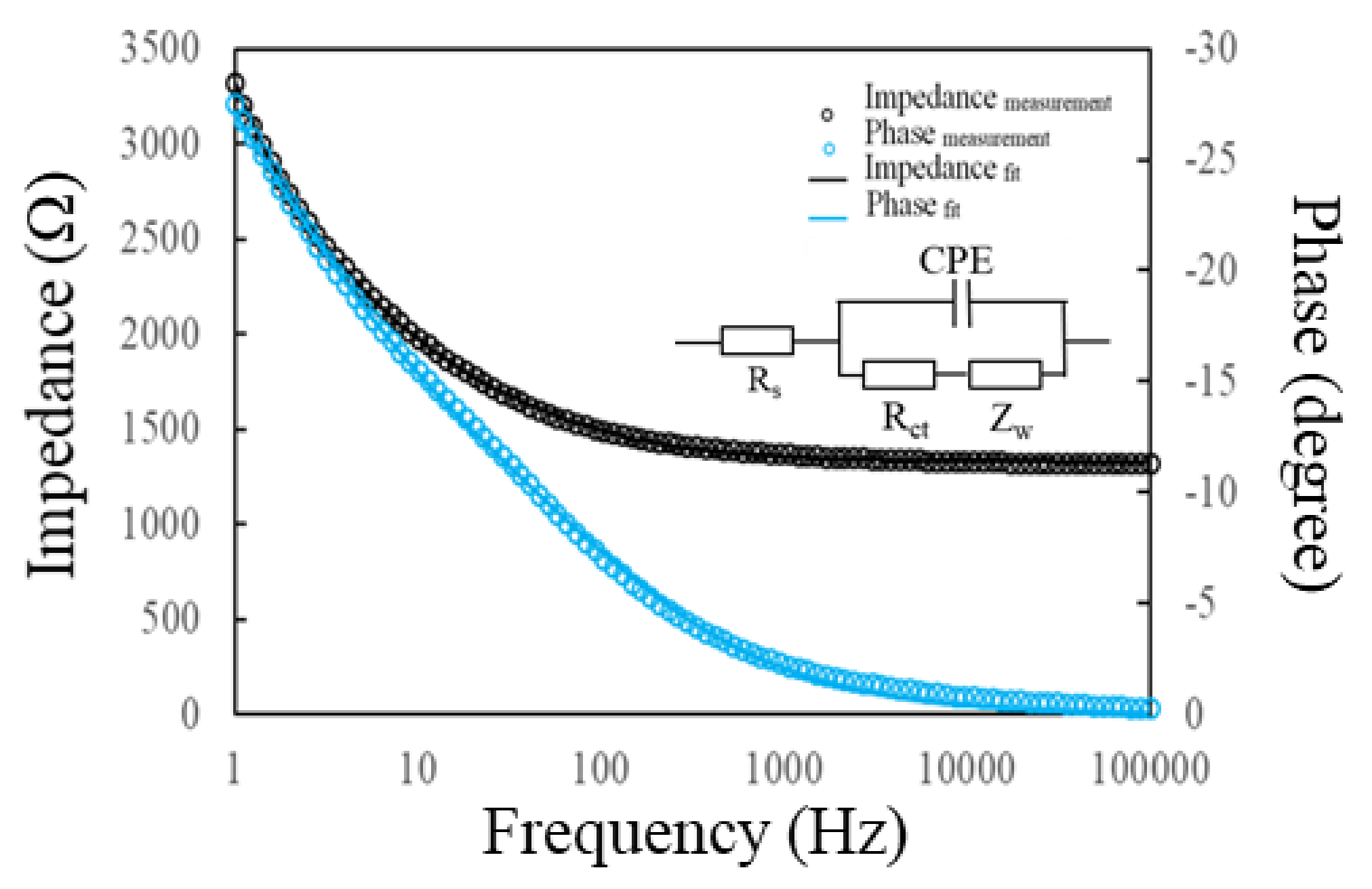
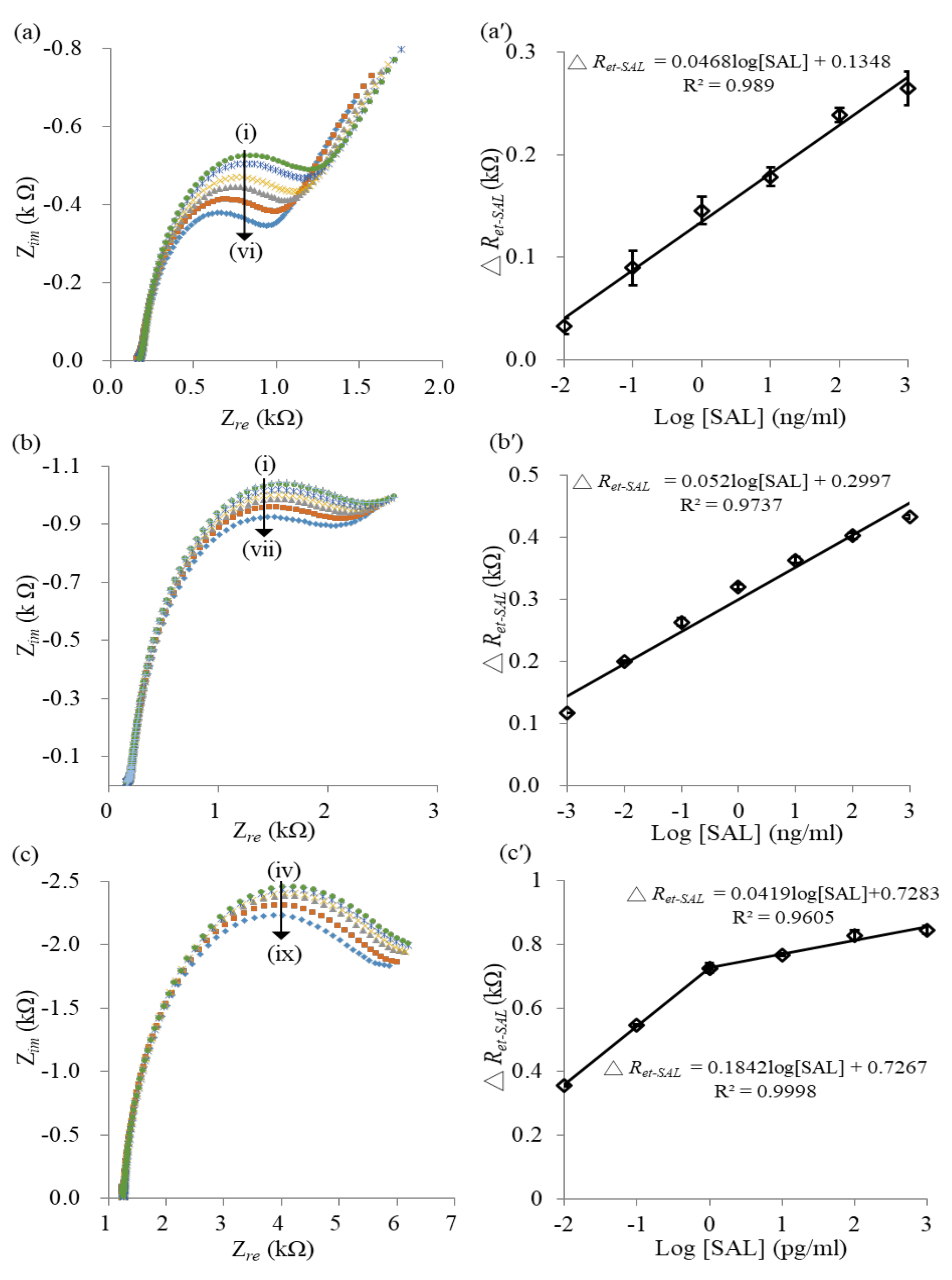
| Modification | Ret (kΩ) of Different PA:BSA-Modified Electrodes | |||
|---|---|---|---|---|
| 100:0 | 100:50 | 100:100 | 100:200 | |
| AuNS | 0.07 ± 0.00 | 0.08 ± 0.00 | 0.08 ± 0.00 | 0.08 ± 0.00 |
| MPA | 0.71 ± 0.01 | 0.72 ± 0.01 | 0.74 ± 0.01 | 0.72 ± 0.01 |
| PA:BSA (μg/mL) | 2.68 ± 0.06 | 2.94 ± 0.02 | 3.10 ± 0.06 | 3.00 ± 0.06 |
| Anti-SAL | 3.43 ± 0.01 | 3.77 ± 0.01 | 4.08 ± 0.01 | 3.14 ± 0.02 |
| ΔRet-PA:BSA | 1.97 ± 0.06 | 2.22 ± 0.02 | 2.36 ± 0.01 | 2.28 ± 0.06 |
| ΔRet-anti-SAL | 0.75 ± 0.06 | 0.83 ± 0.01 | 0.98 ± 0.01 | 0.14 ± 0.02 |
| Electrodes | Methods | Linear Range | LOD | Ref. |
|---|---|---|---|---|
| Anti-SAL/AuNS/SPCE | Label-free EIS | 0.1 pg/mL–1 μg/mL | 4 fg/mL | [26] |
| Anti-SAL/SDBS-GS/GCEa | Sandwich immunoassay with Pd@SBA-15b/Ab2 by amperometry | 0.02–15.0 ng/mL | 7 pg/mL | [29] |
| SAL/rGO/SPCE | Competitive immunoassay with AgPd @anti-SAL by LSVb | 0.01–100 ng/mL | 1.4 pg/mL | [30] |
| Aptamer/AuE | Label-free DPVc and EIS | 0.1–10 pg/mL | 0.5 pg/mL | [31] |
| rGO/AuNPs | Anti-SAL magnetic bead purification by surface-enhanced Raman spectroscopy | 1-20 ng/mL | 0.5 ng/mL | [32] |
| -- | Europium-labeled goat anti-mouse IgG by time-resolved fluoroimmunoassay | 0.014–2.32 ng/mL | 0.014 ng/mL | [33] |
| Anti-SAL/PA:BSA/AuNS/SPCE | Label-free EIS | 10 fg/mL–1 ng/mL | 0.2 fg/mL | This work |
| [SAL] (fg/mL) | Recovery (%) | |
|---|---|---|
| Added | Detected | |
| 10 | 9.5 ± 0.7 | 95.1 |
| 100 | 95.7 ± 9.7 | 95.7 |
| 1000 | 989.7 ± 44.7 | 99.0 |
© 2020 by the authors. Licensee MDPI, Basel, Switzerland. This article is an open access article distributed under the terms and conditions of the Creative Commons Attribution (CC BY) license (http://creativecommons.org/licenses/by/4.0/).
Share and Cite
Lin, C.-H.; Lin, M.-J.; Huang, J.-D.; Chuang, Y.-S.; Kuo, Y.-F.; Chen, J.-C.; Wu, C.-C. Label-Free Impedimetric Immunosensors Modulated by Protein A/Bovine Serum Albumin Layer for Ultrasensitive Detection of Salbutamol. Sensors 2020, 20, 771. https://doi.org/10.3390/s20030771
Lin C-H, Lin M-J, Huang J-D, Chuang Y-S, Kuo Y-F, Chen J-C, Wu C-C. Label-Free Impedimetric Immunosensors Modulated by Protein A/Bovine Serum Albumin Layer for Ultrasensitive Detection of Salbutamol. Sensors. 2020; 20(3):771. https://doi.org/10.3390/s20030771
Chicago/Turabian StyleLin, Chia-Hung, Ming-Jie Lin, Jie-De Huang, Yu-Sheng Chuang, Yu-Fen Kuo, Jung-Chih Chen, and Ching-Chou Wu. 2020. "Label-Free Impedimetric Immunosensors Modulated by Protein A/Bovine Serum Albumin Layer for Ultrasensitive Detection of Salbutamol" Sensors 20, no. 3: 771. https://doi.org/10.3390/s20030771
APA StyleLin, C.-H., Lin, M.-J., Huang, J.-D., Chuang, Y.-S., Kuo, Y.-F., Chen, J.-C., & Wu, C.-C. (2020). Label-Free Impedimetric Immunosensors Modulated by Protein A/Bovine Serum Albumin Layer for Ultrasensitive Detection of Salbutamol. Sensors, 20(3), 771. https://doi.org/10.3390/s20030771






